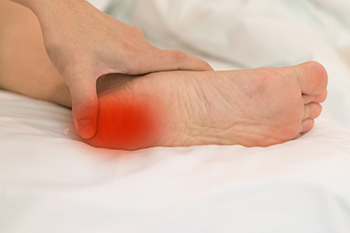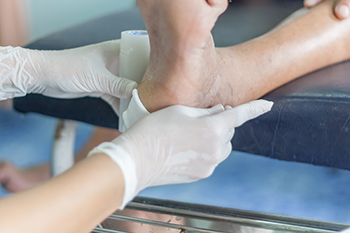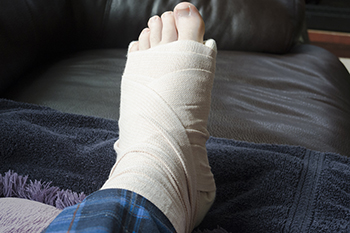Items filtered by date: March 2023
Children’s Foot Blisters

Caring for the health of your growing child importantly includes looking after the health of their feet. Blisters are essentially bubbles that can form underneath the skin that are filled with fluid that is clear. It is common for children to sometimes develop blisters on their feet. However, there are certain signs that parents might consider being on the lookout for because they might indicate that the blister is more serious than usual. These signs include a smelly blister, a blister accompanied with a fever, and discoloration on the skin surrounding the blister. If your child is currently struggling with blisters, then it is highly suggested that you contact a chiropodist for treatment options. This medical professional can effectively address any concerns that you might have about your child’s foot health.
If your child is experiencing foot or ankle pain, please consult with one of the chiropodists from Complete Family Footcare & Therapy. Our clinicians will assess your condition and provide you with quality foot and ankle treatment.
Common Causes of Foot Pain in Children
While children can experience many of the same foot problems as adults do, some foot problems may be more common during childhood.
Causes of foot pain in children can include:
Deformities that are present from birth, such as flat feet or clubfoot
Sever’s disease, which is an inflammation of the growth plate in the heel bone
Various sports injuries, such as sprains and fractures
Ingrown toenails
Athlete’s foot
Plantar warts
Prevention
It is important to look after the health of children’s feet in order to prevent future problems from arising. Keep your child’s feet clean and dry, trim their toenails regularly, ensure their shoes fit properly, and keep a watchful eye on any symptoms of foot pain, such as limping. If you notice any symptoms or if your child complains of foot pain, a chiropodist can help.
If you have any questions, please feel free to contact our offices located in . We offer the newest diagnostic and treatment technologies for all your foot care needs.
What Is Overload Heel Pain Syndrome?

Heel pain, which is a common complaint, is generally attributed to a condition called plantar fasciitis. However, the pain may be caused by another condition, known as overload heel pain syndrome. Rather than the more generalized pain from plantar fasciitis, the soft tissues and heel pad are the source of the overload heel pain. People who are overweight, spend a lot of time standing or walking, or have high arches are more at risk for this condition. Some patients with overload heel pain syndrome have an increased ability to flex the foot toward the leg. This contributes to the excess pounding on the heel while walking. Non-surgical treatment is usually effective in reducing this type of heel pain. It is suggested that you consult with a chiropodist for more information.
Heel pain is a common problem that can be caused by a variety of injuries, medical conditions, and other factors. If you suffer from heel pain, please consult with one of the chiropodists from Complete Family Footcare & Therapy. Our clinicians can help you maintain the health of your lower limbs and your mobility.
When it comes to heel pain, the exact location and type of pain are important to note. Some of the conditions that may cause heel pain include:
Plantar fasciitis - An inflammation of the ligament that runs along the bottom of the foot; it causes a stabbing pain under the heel that is at its worst when taking your first few steps after a long rest and while standing on your tiptoes or climbing stairs
Achilles tendonitis - An inflammation of the tendon in the back of the calf; it causes pain in the back of the heel that is at its worst after resting, as well as ankle and calf stiffness, swelling, and tenderness
Bone spurs - Bony lumps on the back of the heel bones that cause sharp pain upon first standing up; the pain becomes dull and achy over time
Heel fractures - A break or crack in the heel bone that causes pain, swelling, and difficulty walking
Retrocalcaneal bursitis - Swelling of the small, fluid-filled sac at the back of the heel bone; it causes pain, swelling, redness, and warmth in the back of the heel
Tarsal tunnel syndrome - Compression of the posterior tibial nerve which causes a pins and needles sensation in the heel, foot, and calf
Your chiropodist will be able to diagnose the underlying cause of your pain and prescribe the right treatments for you. If you have any questions, please feel free to contact our offices located in . We offer the newest diagnostic and treatment technologies for all your foot care needs.
Four Kinds of Wounds on the Feet

An open wound on the feet can have serious complications, especially for diabetic patients. A wound is a break in body tissue generally involving the skin. Wounds can fall into four categories, which are determined by the cause. Rubbing the skin on a hard or rough surface can be referred to as abrasion. An abrasion requires prompt cleaning which may help to prevent an infection from developing. A laceration happens from a deep tear or cut in the skin. This type of wound may be accompanied by extensive bleeding. A puncture wound can be caused by a pointy object, such as a needle. These kinds of wounds generally have limited bleeding, despite possible damage to internal organs. If the skin becomes partly or completely torn, this is known as an avulsion. A wound of this type can be common in accidents. If you have a wound on your foot, it is suggested that you confer with a chiropodist who can determine the best course of treatment for you.
Wound care is the process of treating and preventing wounds on the feet. This is especially important if you have diabetes, as diabetic foot wounds are common and can lead to serious complications when left untreated. To learn more about proper wound care, please consult with one of the chiropodists from Complete Family Footcare & Therapy. Our clinicians will assess your condition and provide you with quality foot and ankle treatment.
Why Is Wound Care Important for Diabetics?
While wound care is important for maintaining the health of your feet, it is especially important for people with diabetes. This is because diabetics often suffer from poor blood circulation, causing foot wounds to heal very slowly or not to heal at all. Diabetics also frequently suffer from neuropathy or nerve loss. This means no matter how big or little the wound, they might not feel it on their foot. If the wound becomes severely infected, amputation may be necessary. This is why it is imperative that diabetics complete daily foot checks.
Wound Care Basics
The best way to care for wounds is to prevent them in the first place. It is recommended that people with diabetes perform a daily examination of their feet to locate cuts, scrapes, sores, or wounds. Early detection allows for ample time to treat the wounds and prevent further complications. If you notice a wound at home, you can clean it using water, apply an antibiotic ointment, and cover the wound with a clean bandage. Seeing a chiropodist, who can examine your feet thoroughly and treat any existing wounds, can also help you maintain proper foot health.
If you have any questions, please feel free to contact our offices located in . We offer the newest diagnostic and treatment technologies for all your foot care needs.
Broken Versus Sprained Feet

Foot injuries can result in broken bones, and it is often necessary to seek medical intervention. Broken bones can range from small cracks or splinters to complete breaks of a bone. Severe breaks can pierce through the skin and are known as open fractures. A bulging area near an injury can indicate a broken foot, as can pain, bruising, and trouble bearing weight. Sprains are sometimes confused with fractures because symptoms can be similar, but a sprain is when the tissue or ligaments between the bones tear or stretch rather than there being a break in a bone. If you have injured your foot and believe it might be broken, it is suggested that you see a chiropodist as soon as possible for diagnosis and recommended treatment.
A foot fracture is a crack or break in a foot bone, often caused by repetitive stress on the foot or a high-impact foot injury. If you’re suffering from foot pain, please consult with one of the chiropodists from Complete Family Footcare & Therapy. Our clinicians can help you maintain the health of your lower limbs and your mobility.
Symptoms
Pain
Bruising
Tenderness
Swelling
Difficulty walking
Deformity
Causes
Repetitive overloading of the foot
Having a previous fracture
Abnormal foot biomechanics
Changing training surfaces suddenly
Poor footwear
Osteoporosis
High-impact injury
Treatments
Rest
Ice
Elevation
Pain medication
Braces or other orthotics
Casts
Crutches
Surgery in more severe cases
If you have any questions, please feel free to contact our offices located in . We offer the newest diagnostic and treatment technologies for all your foot care needs.

